Illinois, Missouri, Kansas, Oklahoma, Texas, New Mexico, Arizona, California
June 4-14, 2008
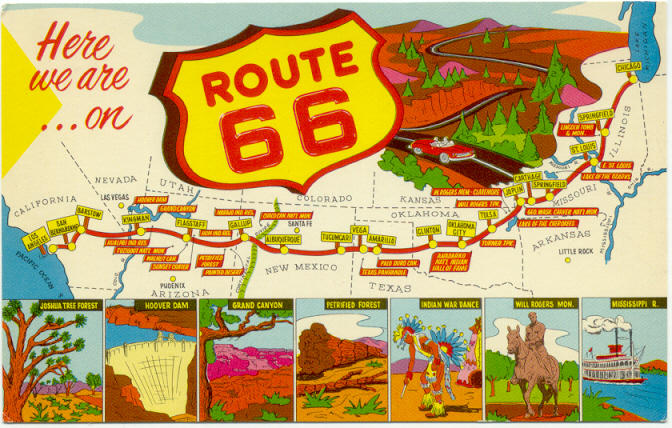
| Route 66 Illinois, Missouri, Kansas, Oklahoma, Texas, New Mexico, Arizona, California June 4-14, 2008 |
 |
![]()
"Thanks to the interstate highway system, it is now possible to travel from coast to coast without seeing anything." - Charles Kuralt
Route 66 was conceived by a man named Cyrus Avery, an Oklahoma highway commissioner, who in the spring of 1925 launched a scheme to replace the old trails network of roads with a numbered, clearly signposted system of national highways. These routes were based on existing roads, and federal aid would be provided to upgrade, widen and join them. One of the most significant of these routes was the key east-west thoroughfare from Chicago to Los Angeles. It was officially commissioned in November 1926 but it wasn’t completely paved until the mid 1930’s.
Route 66 became the most famous highway in the United States. It was more popular than Route 1 running from Maine to Key West, Florida, more traveled than Highway 101 on the Pacific coast and better known than the Pennsylvania Turnpike. It became the star of more stories, book, songs, movies and television shows than any other highway in the United States. John Steinbeck dubbed Route 66 as the “Mother Road” in the Grapes of Wrath. Nat “King” Cole, the Andrews Sisters, the Rolling Stones and Bobby Troup were some of the hundreds of artists who sang “Get your kicks on Route 66”. And then there was the TV show route 66 (the “r” was not capitalized) running from 1960-1964 starring George Maharis as Buz and Martin Milner as Tod, two guys riding around in a cool 1960 Corvette convertible.
Route 66 was known by many names in different parts of the country: The Pontiac Trail, Osage Indian Trail, Wire Road, Postal Highway, Grand Canyon Route, National Trails Highway, Ozark Trail, Will Rogers Highway and because it went through the center of so many towns, it became known as The Main Street of America. I like to call it the Old Road.
In the 1950’s Route 66 reached its height of popularity. For family vacations, it was a popular route to see the Grand Canyon, the Petrified Forest, the Painted Desert, towns where Jesse James robbed banks and Meramec Caverns where he hid out, Abraham Lincoln’s home and the great Mississippi River that Mark Twain wrote about.
Eventually the interstate highway system replaced Route 66 and the last section was bypassed by Interstate 40 in 1984 at Williams, Arizona. Because the interstate highways bypassed so many towns along the old route, many businesses closed and some whole towns became “ghost towns”.
Route 66 has had a resurgence in popularity for those of us who are into American history and nostalgia. Surprisingly, you can still drive on 85% of the original 2,297 miles (3,696 km) of road and see many of the original (either closed, still operating or restored) “roadside attractions” including diners, filling stations, drive-in cinemas, museums, trading posts/rest stops, historic bridges, hotels and motels. There are many books, guides, maps and even a magazine dedicated to Route 66.
We started planning our Route 66 trip months in advance. It was definitely not an easy trip to plan. First of all, the old Route 66 is not marked on most modern road maps so we purchased a special set of eight maps (one for each state Route 66 goes through) giving turn-by-turn directions. Secondly, Route 66 actually changed some over the years when new alignments replaced old unpaved or longer routes so you have to decide which alignments to drive on. Thirdly, we wanted to stay in some of the historic hotels and motels along the route so we had to pick ones that were spaced far enough apart so we wouldn’t have to drive too far or not far enough between them.
Next we had to plan what we wanted to see along the way. Fortunately, we had already driven on parts of Route 66 on previous trips and seen many of the nearby attractions such as the Grand Canyon, Meteor Crater, Painted Desert and Petrified Forest so that gave us more time to see other attractions. We planned several side trips along the way and had to budget time for those. And finally, for various reasons, we planned eleven days for this trip. That’s pretty ambitious. If you really wanted to drive every mile of the remaining old route and see all the Route 66-related attractions along the way, I believe you would need at least three weeks and you should be flexible on where you stayed each night. Our goal was to drive on as much of the old route (and avoid the interstates), see as many roadside attractions and make as many side trips as our time would allow. Kathy planned the majority of this trip and she did a great job as we saw and did almost all of what we planned.
Armed with our itinerary/list, special maps, AAA maps, AAA tour books, a Route 66 dining and lodging guide, a large Route 66 coffee table book and a GPS navigator, we flew from Sacramento to Midway airport in Chicago. Kathy was able to find a rental car company that was about $500 cheaper than any other company for one-way rentals. Their only Chicago office is at O’Hare airport so we took a shuttle bus from Midway to O’Hare and picked up our car (wish we could have rented a Corvette but we settled for a comfortable Hyundai Sonata). We proceeded directly to the intersection of Jackson Boulevard and Lake Shore Drive in downtown Chicago – one of the original official starting points of Route 66. The original route now goes right by the Sears Tower as it heads east and south out of Chicago.
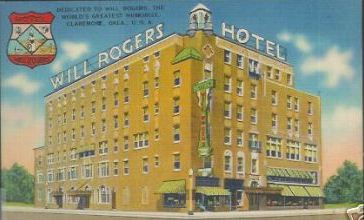 We must have seen hundreds of hotels and motels along the Old Road that were closed and in various states of decay. But there are still some places hanging in there and we wanted to stay in a few of those.
We must have seen hundreds of hotels and motels along the Old Road that were closed and in various states of decay. But there are still some places hanging in there and we wanted to stay in a few of those.
One of the most famous motels we stayed at was the Blue Swallow Motel in Tucumcari, New Mexico. It opened in 1942 and is the oldest continuously operated motel on the Old Road. When we pulled up, Kathy started to have second thoughts about staying there but it turned out OK. There are only about twelve rooms and most have a garage for your car located next to them. The owner greeted us and showed us our room before we paid because “that’s the way we do it”. The room was tiny but clean and it even had wi-fi that worked as opposed to some of the newer places we stayed at.
The owner told us that everyone usually sits outside and drinks beer in the evening and proceeded to show us their outside rest area complete with a refrigerator stocked with beer. He told us everyone was on the honor system regarding the beer and we were welcome to have one of his. There was an older biker staying in the room next to us (he may have been living there) and we saw several bikers driving up and down the Old Road in front of the motel.
The Blue Swallow Motel is famous for its neon sign and trim lights and the owner turned them on at twilight so we could take photos. He insisted on taking our photo under the sign too. He only turns the neon lights on for a short time as they are expensive to run. We got a six pack figuring we’d be drinking beer with the bikers but no one else showed up so we enjoyed a few beers in the rocking chairs (made by the owner) in front of our room and watched the world go slowly by on the Old Road.
Another Route 66 landmark we stayed at is the Munger Moss Motel in Lebanon, Missouri. It was built in 1946 and started out as a series of freestanding cabins incorporating garages. Eventually the garages were converted into rooms to create a modern motel layout. We stayed in the Route 66 room which has dozens of photos of various roadside attractions along the Old Road on the walls. It also had an interesting guest book in the room. We read some of the entries and discovered that people come from all over the world to travel on the Old Road. People from Europe and South Africa had entered comments in the book – all favorable, I might add.
In Gallup, New Mexico, we stayed at the restored El Rancho Hotel, which dates from 1937, and was popular with Hollywood greats such as Spencer Tracy, Katherine Hepburn and Kirk Douglas as many movies were filmed in the area. The El Rancho has a great old lodge-style lobby and that is the only place were their wi-fi works so there were dozens of people sitting in there using their lap top computers – kind of a funny site in such a rustic looking place. Every room was named after a movie star and we stayed in the Paulette Goddard room.
Some other historic hotels we saw were the six-story Will Rogers Hotel opened in 1930 in Claremore, Oklahoma. In its heyday, it provided luxurious accommodations including baths fed from nearby artesian springs. We saw two Wigwam Motels both opened in 1950, one in, Holbrook, New Mexico and the other in Rialto, California. Their individual rooms look like tee pees. Another landmark hotel we saw was the El Rancho Hotel in Barstow, California said to be built out of railroad ties.
We also saw three of the many old “Harvey Houses” built by British immigrant Fred Harvey to provide fine lodging and meals along the Santa Fe Railroad: The restored and reopened La Posada in Winslow, Arizona, the El Garces in Needles, California currently being restored and the Casa del Desierto, restored and now a museum and unstaffed Amtrak station in Barstow, California.
In 1883, unhappy with the conduct of his rowdy male service staff (who often picked fights with the customers and arrived at work drunk - or not at all), Fred Harvey implemented a policy of hiring only female waitresses. He sought out single, well-mannered, and educated ladies, and placed ads in newspapers throughout the east coast and midwest for "Young women, 18 to 30 years of age, of good character, attractive and intelligent." The girls were paid $17.50 a month plus room, board, and tips to start, a generous income by the standards of the time.
These “Harvey Girls” as they became known are said to have helped to "civilize the American Southwest." There was even an MGM musical made in 1946 called “The Harvey Girls” starring Judy Garland. It was inspired by a 1942 novel by the same name.
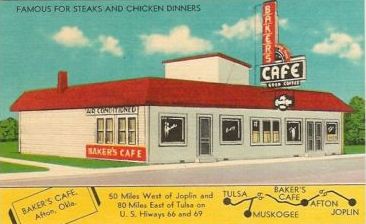 This was not a trip where healthy eating was possible. We just had to eat at some of the famous diners still operating on the Old Road after all these years. We didn’t waste any time as we stopped for dinner just outside Chicago at Del Rhea’s Chicken Basket, serving great fried chicken since 1949. They had a five piece band playing Big Band music shortly after we arrived and the place became packed.
This was not a trip where healthy eating was possible. We just had to eat at some of the famous diners still operating on the Old Road after all these years. We didn’t waste any time as we stopped for dinner just outside Chicago at Del Rhea’s Chicken Basket, serving great fried chicken since 1949. They had a five piece band playing Big Band music shortly after we arrived and the place became packed.
In Springfield, Missouri, we ate lunch at the Cozy Diner, home of the Cozy Dog. It was founded in 1949 by Ed Waldmire who claims to be the creator of the corn dog. Ed’s son Buz has run the Cozy Diner since Ed died in 1993. The Cozy Dogs (don’t call them corn dogs there) were good but like after eating most deep fried foods, I needed a couple of antacid tablets.
In Amarillo, Texas, we stopped at the Big Texan Steak Ranch for lunch. Their claim to fame is their 72 oz. steak. If you can eat it all in 60 minutes, it’s free. If you don’t finish it, it’s $72.00. I’m surprised they didn’t have a stomach pump on standby. It’s a huge place and up front by where the cooks do their thing is a table with a timer set at 60 minutes. There is a board on the wall displaying the names of people who actually “ate the whole thing” in under 60 minutes. More than 40,000 people have attempted to eat the giant steak for free and about 7,000 have actually succeeded. The place is rather kitschy, (a nicer word for tacky) but we enjoyed it. I had a half pound buffalo burger that was quite tasty.
About 50 miles (80 km) up the road from Amarillo, we had a slice of pecan pie at the Midpoint Café. It is located in Adrian, Texas which is the official mid point on Route 66. Adrian claims to be 1,139 miles (1,833 km) from both Chicago and L.A. although definitive mileages are impossible to calculate due to the variations of the old road over time. The Midpoint Café had been in business (under different names) since the 1920’s and is the oldest continuously run café anywhere on Route 66 in Texas, Oklahoma or New Mexico.
We ate lunch at the Route 66 Diner in Albuquerque, New Mexico. This diner was built inside the shell of a 1940’s Phillips gas station. It has great neon lights on the exterior and night views of the diner appear on many Route 66 post cards and magnets. They have a sign in the parking lot that reads: “Parking for 66 Diner only. All others will be pounded into flatware”.
There were many other landmark diners located on the Old Road that we passed along the way: the Launching Pad drive-in in Wilmington, Illinois, the Ariston Café opened in 1924 in Litchfield, Illinois, Ted Drewes Frozen Custard just outside of St. Louis, Missouri, the Club Café in Santa Rosa, New Mexico, the Bagdad Café in Newberry Springs, California and the Summit Inn Café serving ostrich burgers located at the top of the Cajon Pass in California.
We also found the site of the very first restaurant opened by Dick and Maurice McDonald in 1948 in San Bernardino, California. They revolutionized the roadside food business and formed the basis for their burger chain’s eventual global dominance. While I’m interested in its history, I haven’t eaten at McDonald’s since 1977 in Germany.
A few diners have closed in the last few years since the book we have was published. One notable eatery that we found closed was Murphey’s Route 66 Café located in Baxter Springs, Kansas. It opened in 1941 but its site had been occupied since 1868. It started out as a grocery and dry goods store and later became the Baxter National Bank. It was robbed by Henry Starr, “The Cherokee Badman” in 1914. The former bank vault made an unusual ladies restroom when the restaurant occupied the site. We peered in the window and it looked like everyone just left one day. If not for the “For Sale” sign in the window, it would almost be hard to tell it was closed.
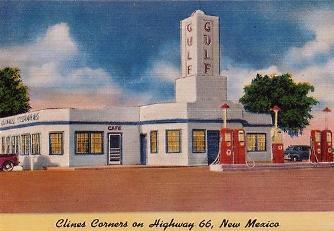 Remember when gas station attendants wore uniforms with hats, filled your tank, checked your oil, water and tire inflation and even cleaned your windshield? Remember when gas was $.15 a gallon? OK, I don’t quite remember all that but once upon a time that was the service you got at “fillin’ stations” as I like to call them. We saw hundreds of old closed gas stations along the Old Road. You could tell approximately when some went out of business as they still had gas prices posted. We also saw many classic old restored filling stations. Some of these were beauties: the Sinclair Station in Odell, Illinois and my favorite, the Art Deco-influenced U-Drop Inn and Tower gas station in Shamrock, Texas. Both opened in 1932.
Remember when gas station attendants wore uniforms with hats, filled your tank, checked your oil, water and tire inflation and even cleaned your windshield? Remember when gas was $.15 a gallon? OK, I don’t quite remember all that but once upon a time that was the service you got at “fillin’ stations” as I like to call them. We saw hundreds of old closed gas stations along the Old Road. You could tell approximately when some went out of business as they still had gas prices posted. We also saw many classic old restored filling stations. Some of these were beauties: the Sinclair Station in Odell, Illinois and my favorite, the Art Deco-influenced U-Drop Inn and Tower gas station in Shamrock, Texas. Both opened in 1932.
 Rest stops and trading posts were popular on the old road especially back when driving long distances without stopping was less common. The trading posts are mostly in the Southwest and carry large stocks of nice Native American crafts, “curios” or just plain tacky items like stuffed armadillos dressed up like cowboys.
Rest stops and trading posts were popular on the old road especially back when driving long distances without stopping was less common. The trading posts are mostly in the Southwest and carry large stocks of nice Native American crafts, “curios” or just plain tacky items like stuffed armadillos dressed up like cowboys.
Some notable places we stopped at include Clines Corners Rest Stop in Clines Corners, New Mexico offering gas and refreshments on the Old Road since the late 1920’s, the Yellow Horse Trading Post in Lupton, Arizona which is located in a large Navajo Reservation and one of the best-known, most effectively advertised businesses anywhere on Route 66 – the Jackrabbit Trading Post near Joseph City, Arizona. The Jackrabbit Trading Post was opened in 1947 and the original owner, James Taylor was obsessed with advertising for his business. To this day, there are dozens of “Here it is” signs with jackrabbits on them pointing the way along the Old Road as well as along the Interstate.
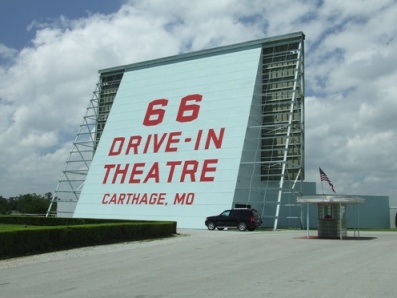 The very first drive-in cinema opened in Camden, New Jersey on June 6, 1933. At its height of popularity in the 1950’s there were nearly 5,000 drive-ins in the U.S. In the late 1960’s, there was a steep decline and today, according to one web site, there are only about 500 drive-ins operating nationwide. We still have one multi-screen drive-in theater here in Sacramento.
The very first drive-in cinema opened in Camden, New Jersey on June 6, 1933. At its height of popularity in the 1950’s there were nearly 5,000 drive-ins in the U.S. In the late 1960’s, there was a steep decline and today, according to one web site, there are only about 500 drive-ins operating nationwide. We still have one multi-screen drive-in theater here in Sacramento.
There were 38 drive-ins operating along the Old Road at one time but today there are only seven still open. We saw two of them: the Frisina Sky View on the outskirts of Litchfield, Illinois and the 66 Drive-in in Carthage, Missouri.
We also found one drive-in cinema right next to a remote section of the Old Road that by its condition, had obviously been closed for many years. Drive-in cinemas and drive-in diners reflected America’s love affair with their cars. It looks like those affairs are coming to an end maybe partly due to the ever rising cost of gas.
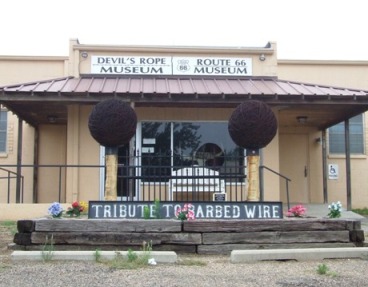 There are several notable museums along the old road: the Will Rogers Memorial/Museum in Claremore, Oklahoma, the Devil’s Rope (barbed wire) Museum in McLean, Texas and the Howard Litch Museum in Galena, Kansas to name a few.
There are several notable museums along the old road: the Will Rogers Memorial/Museum in Claremore, Oklahoma, the Devil’s Rope (barbed wire) Museum in McLean, Texas and the Howard Litch Museum in Galena, Kansas to name a few.
The first museum we stopped at was the Jesse James Museum in Stanton, Missouri. There are a few artifacts that once belonged to Jesse and Frank James, a large gun collection, etc. but the theme of the museum is the theory that Jesse James faked his death by assassination in 1882 in St. Joseph, Missouri and lived to be 104.
On September 5th 1947, J. Frank Dalton of Lawton, Oklahoma, came forth with the astonishing claim that he was the notorious bandit, that he had engineered his own death in order to live a peaceful existence, and that he wanted to set the record straight once and for all before he died. Even though Mr. Dalton was 100 at the time, he presented some very convincing evidence including matching bullet scars on his body. He apparently convinced many people including the original owners of the museum that he really was Jesse James and became quite a celebrity before he died in 1951.
In an attempt to put an end to the dispute, the body buried in Missouri as Jesse James was exhumed in 1995 and the subsequent DNA analysis resulted in a 99.7% probability that the remains were indeed those of the famed outlaw. Still unwilling to accept this, Dalton's proponents got a court order in 2000 to exhume and test Dalton's body to solve the mystery "once and for all." Unfortunately, the wrong body was exhumed, and Dalton's remains have yet to be tested.
There are a few Route 66 Museums along the Old Road and we decided to see the Oklahoma Route 66 Museum in Clinton, Oklahoma. We also stopped in the Route 66 Visitor Center located in the Old Hackberry Store in Hackberry, Arizona. It houses a rather eclectic collection of Route 66 memorabilia, old cars, a restored vintage Corvette and even has a “Meditation Pond”. We met a biker couple there. The “old lady” had a Chihuahua in a pet carrier strapped on the back of her bike and told us the dog had 20,000 miles (32,187 km) under its collar.
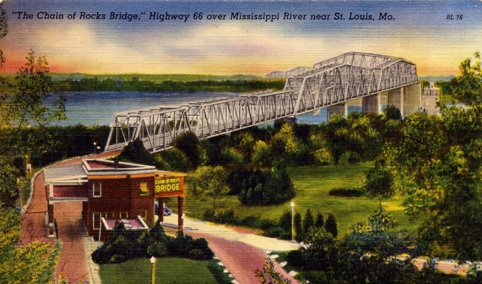 There are many historic bridges on the Old Road. You can still drive across many of them but some are closed to cars. We drove across many and walked on the ones that are closed.
There are many historic bridges on the Old Road. You can still drive across many of them but some are closed to cars. We drove across many and walked on the ones that are closed.
One notable bridge we walked on was the Chain of Rocks Bridge which spans the Mississippi River a few miles north of St. Louis, Missouri. The bridge, named after the nearby rapids was completed in 1929.
It was an engineering marvel spanning 5,353 feet (1,632 m) and has a 24 degree bend at its midpoint. In 1968, it was closed and fell into disrepair but has since been restored and it now links a network of walking and cycling trails in Missouri and Illinois.
Another notable bridge we saw is the “Graffiti” Rainbow Arch Bridge over Brush Creek near Baxter Springs, Kansas. Hundreds of Rainbow Arch bridges designed by James Marsh were constructed in the 1910s, 1920s and 1930s because of their popular design and appearance. This one is the only Marsh Rainbow Arch Bridge along the Old Road in Kansas that was not demolished.
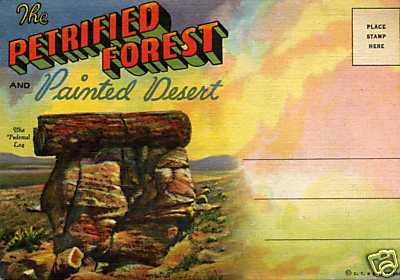 As mentioned earlier, you can make several side trips off of the Old Road. Probably the most well-known of these is to see the Grand Canyon. We actually were able to see the North Rim of the Grand Canyon from one stretch of the Old Road. Our side trips were to see a few well known and several lesser known sites. Our GPS Navigator came in handy when looking for these places.
As mentioned earlier, you can make several side trips off of the Old Road. Probably the most well-known of these is to see the Grand Canyon. We actually were able to see the North Rim of the Grand Canyon from one stretch of the Old Road. Our side trips were to see a few well known and several lesser known sites. Our GPS Navigator came in handy when looking for these places.
Our first side trip was to see the Lincoln Home National Historic Site in Springfield, Illinois which includes Abe Lincoln’s home and several other nearby historic homes. We also saw the Old and New State Capitol buildings in Springfield, the former containing the desk Lincoln used as a state legislator and the place where he gave his famous “House Divided” speech.
Just a few blocks from Lincoln’s home, we took a tour of Frank Lloyd Wright’s Dana-Thomas House completed in 1900. We have now seen many of Wright’s houses and buildings and we were quite impressed with this one. It is huge as Mrs. Dana was very wealthy and had the house designed for entertaining. It has the most art glass windows of any Wright house we have seen and much of the original furniture (Wright always designed the furniture for his houses). The exterior has a large amount of copper lattice work and this house must have looked like something from the 21st century when it was completed.
We stayed at an old Victorian Bed and Breakfast in St. Charles, Missouri – one of the nicest B&Bs we have stayed in. We went in to the historic old town for dinner and later strolled along the Missouri River. St. Charles is where Lewis and Clark started their incredible Journey of Discovery.
In St. Louis, we saw the Gateway Arch and the Ulysses S. Grant National Historic Site which includes Grant’s house and a huge barn. The house is painted an odd green color which may or may not be the original color and really blends in with the trees and grass.
Our next side trip was to see Wilson’s Creek National Battlefield. This was the site of the first major Civil War Battle in Missouri. Brigadier General Nathaniel Lyon who commanded the Union forces at Wilson’s Creek became the first Union General to die in battle during the Civil War. We visited the Ray House which is where General Lyon’s body was taken. The original bed that they put his body on is still there. We also hiked a short distance on Bloody Hill.
Before leaving Missouri, we made one more side trip. We visited the George Washington Carver National Monument near the town of Diamond. The National Monument consists of a museum showcasing Carver’s rise from slavery to earning a Masters of Agriculture degree in 1896 and teaching at the Tuskegee Institute, the original house where Carver was raised and a trail in the area where Carver grew up and became fascinated with nature. Along the trail, there are plaques containing quotes of Carver and my favorite is:
“How far you go in life depends on your being tender with the young, compassionate with the aged, sympathetic with the striving and tolerant of the weak and strong. Because someday in your life you will have been all of these.”
Our next side trip was also our most out of the way from Route 66. We drove a total of about 80 extra miles (129 km) to Bartlesville, Oklahoma to see, you guessed it, a Frank Lloyd Wright designed building. This one is special though. The 17 story Price Tower was completed in 1956 and it is the only Frank Lloyd Wright designed skyscraper that was actually built. He designed a mile high skyscraper which was far-fetched at the time but the Burj Dubai being built in Dubai right now is going to be over a half-mile high.
The Price Tower is a copper trimmed crystalline design and is either very unusual or very ugly depending on your point of view. The building now houses a Frank Lloyd Wright museum but we got there on a Sunday and it was closed. The front door to the lobby was open so we went in and were surprised to find a woman in an office there. We told her we just wanted to have a look around and she suggested we take the elevator up to the top floor restaurant. We did and were able to roam around the closed restaurant and open air patio at the top. Only in a small town would they let you do something like that and it was a great thrill!
In Tulsa, Oklahoma, we saw another Frank Lloyd Wright designed house. This one was built for Wright’s cousin, Richard Lloyd Jones. It is a textile block design and was built in 1929. This one is still a private residence so we could only admire it from the outside and unlike many of Wright’s houses, you can actually see much of the exterior from the street.
The old road goes through Oklahoma City, Oklahoma. We stayed at another Bed and Breakfast there which reminded me of an old manor. While in Oklahoma City, we had dinner in their Bricktown area which is a little like the River Walk in San Antonio, Texas. It has a “river” flowing through it, many nice restaurants, a movie multi-screen theatre and a AAA baseball park.
After dinner, we went to the Oklahoma City Memorial built on the site of the Alfred P. Murrah Federal Building destroyed by a bomb on April 19, 1995. We got there around 8:00 p.m. and were surprised to see a Park Ranger still there. I had been there before but not in the evening. The Ranger gave a talk about the memorial and at about 8:30, the lights under the 168 chairs (one for each victim of the bombing) came on creating a whole different atmosphere. Because of the lights, the chairs appear to be floating and the names of each victim stand out better.
The next day before heading out of Oklahoma City, we stopped to tour the State Capitol. The Oklahoma State Capitol is the only capitol in the world surrounded by working oil wells. The well directly south of the building's south entrance is nicknamed "Petunia #1" because the drilling began in the middle of a flower bed in 1941. The well was completed in 1942 and produced up to 600 barrels of oil a day before running dry in 1986. A dome was finally added to the building in 2002, 85 years after the building was dedicated. Apparently, Oklahoma couldn’t afford a dome for all those years.
Near Flagstaff, Arizona, we went to Walnut Canyon National Monument. We passed this place up on a previous trip through the area but heard it was worth seeing. It contains several cliff dwellings built between 1125 and 1250. Unfortunately, the trail down into the canyon taking you near the cliff dwellings was closed due to a landslide. We hiked the rim trail instead and were still able to see many of the cliff dwellings across the canyon. It was nice getting out and doing a little hiking after all the driving we were doing.
From Oatman, Arizona (the old gold-mining town on Route 66 where donkeys walk around loose on the street), we drove about 20 miles (30 km) north to stay at the Tropicana Express Hotel and Casino in Laughlin, Nevada. Laughlin is like a mini Las Vegas situated right on the Colorado River. We had a typical casino all-you-can-eat buffet dinner there and played a few coins in the poker and slot machines. We are not big gamblers but it was nice staying in a deluxe room which was also very cheap.
We also took two more short detours to see the Frank Lloyd Wright designed textile block house called La Miniatura House in Pasadena, California completed in 1923 and the futuristic Frank Lloyd Wright designed Anderson Court Shops built in 1952 on Rodeo Drive in Beverly Hills, California. I could spend a whole day just people watching on Rodeo Drive. It’s definitely a different world there!
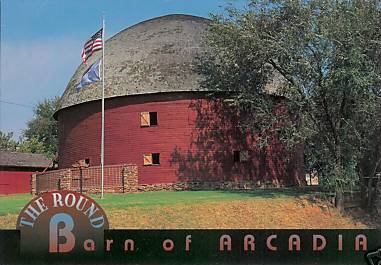 There are many roadside attractions along the Old Road. Some are marked with official Route 66 Roadside Attraction signs but many aren’t. A few of the more kitschy attractions we saw worth mentioning here are the Gemini Giant statue in Wilmington, Illinois, a 20 foot (6 m) tall statue of an astronaut standing next to the Launching Pad Drive-in Restaurant; the 80 foot (23 m) long Blue Whale, a pier built to look like a Blue Whale located on a pond in Catoosa, Oklahoma; the Round Barn, a 60 foot (18 m) diameter restored barn in Arcadia, Oklahoma built in 1898; The “World’s Largest Rocking Chair” (I’m estimating it is 80 feet (23 m) tall) in Missouri; and our favorite, the Cadillac Ranch near Amarillo Texas. Cadillac Ranch consists of ten old Cadillacs, each half buried in the ground at an angle. They are all covered in spray paint and cans are passed from one visitor to another. We added our “art” to the “sculpture”.
There are many roadside attractions along the Old Road. Some are marked with official Route 66 Roadside Attraction signs but many aren’t. A few of the more kitschy attractions we saw worth mentioning here are the Gemini Giant statue in Wilmington, Illinois, a 20 foot (6 m) tall statue of an astronaut standing next to the Launching Pad Drive-in Restaurant; the 80 foot (23 m) long Blue Whale, a pier built to look like a Blue Whale located on a pond in Catoosa, Oklahoma; the Round Barn, a 60 foot (18 m) diameter restored barn in Arcadia, Oklahoma built in 1898; The “World’s Largest Rocking Chair” (I’m estimating it is 80 feet (23 m) tall) in Missouri; and our favorite, the Cadillac Ranch near Amarillo Texas. Cadillac Ranch consists of ten old Cadillacs, each half buried in the ground at an angle. They are all covered in spray paint and cans are passed from one visitor to another. We added our “art” to the “sculpture”.
We also saw the tombs of Will Rogers in Claremore, Oklahoma and Mary “Mother” Jones in Mt. Olive, Illinois and several murals painted on the sides of buildings, some of which are now pretty faded. The “Standing on the Corner in Winslow, Arizona” mural is one of the better ones.
 I guess you could say we were pretty lucky with the weather considering we were driving through “Tornado Alley” in the height of tornado season. We drove through a couple of real downpours in Missouri, came within 30 miles (48 km) of a reported tornado in Lebanon, Missouri and survived a severe thunder storm in Oklahoma City (the power in our Bed and Breakfast was out from 4:00 a.m. to 7:30 a.m.). Once we left the panhandle of Texas, we had clear skies the rest of the way to California. It was maybe 100 degrees (37.8 degrees Celsius) in the Mojave Dessert but it can get a whole lot hotter than that. The motel pool In Barstow, California provided some nice relief from the heat there.
I guess you could say we were pretty lucky with the weather considering we were driving through “Tornado Alley” in the height of tornado season. We drove through a couple of real downpours in Missouri, came within 30 miles (48 km) of a reported tornado in Lebanon, Missouri and survived a severe thunder storm in Oklahoma City (the power in our Bed and Breakfast was out from 4:00 a.m. to 7:30 a.m.). Once we left the panhandle of Texas, we had clear skies the rest of the way to California. It was maybe 100 degrees (37.8 degrees Celsius) in the Mojave Dessert but it can get a whole lot hotter than that. The motel pool In Barstow, California provided some nice relief from the heat there.
 The last hundred miles (161 km) or so of the trip was the toughest. The reason was the Old Road follows Foothill Boulevard starting in San Bernardino, California through many cities – Rialto, Fontana, Rancho Cucamonga, Upland, etc. all the way to Pasadena. Then after a stretch on the Arroyo Parkway (the 110 Freeway), the Old Road follows Santa Monica Boulevard which stretches all the way through Los Angeles, Hollywood, Beverly Hills, etc. to the official end at Ocean Avenue and Santa Monica Boulevard in Santa Monica, California.
The last hundred miles (161 km) or so of the trip was the toughest. The reason was the Old Road follows Foothill Boulevard starting in San Bernardino, California through many cities – Rialto, Fontana, Rancho Cucamonga, Upland, etc. all the way to Pasadena. Then after a stretch on the Arroyo Parkway (the 110 Freeway), the Old Road follows Santa Monica Boulevard which stretches all the way through Los Angeles, Hollywood, Beverly Hills, etc. to the official end at Ocean Avenue and Santa Monica Boulevard in Santa Monica, California.
We figured we had to get to the end by 2:30 p.m. in order to have time to turn in our rental car and get to the airport for our flight home to Sacramento. Needless to say, the traffic was bad that whole stretch but we still made it to the end at 2:00 p.m. We lucked out and found a parking space about a block from the Will Rogers plaque marking the end of the Will Rogers Highway. Standing at the plaque was like making it to the moon. We high-fived and kissed each other and asked a local guy to take our photo. I was overcome with a sense of euphoria as I realized how far we had come to that point and how much we had seen (we took over 700 photos and 1½ hours of video!).
As I reflect back on this trip, I think my favorite “Roadside Attraction” was the Old Road itself. As we traveled over the tan colored Portland concrete, I could imagine the thousands of families thrilled to be heading out on vacations to see Meramec Caverns, the Grand Canyon, Meteor Crater, the Petrified Forest or the Painted Dessert or the thousands of dust bowl migrant workers heading for hopefully a better life in California.
I don’t know what we can do to top this road trip. Perhaps we could drive it again someday, this time from west to east, staying in different motels and seeing all the things we missed. Or maybe we’ll drive the old Lincoln Highway between New York and San Francisco. There will always be more places to see and new roads to travel in this great country of ours!
To view more images from this trip, click on the forward arrow below this photo.![]()